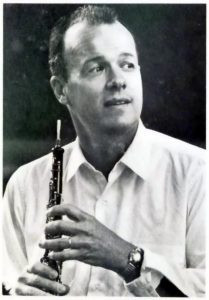John De Lancie stands as a monumental figure in the world of classical music, not only as one of the 20th century’s preeminent oboists but also as the catalyst behind Richard Strauss’s exquisite Oboe Concerto. Born on July 26, 1921, in Berkeley, California, and passing away on May 17, 2002, in Walnut Creek, California, de Lancie’s legacy resonates through his exceptional performance career, his influential teaching, and his unique contribution to the oboe repertoire.
A Distinguished Career as Oboist and Educator
De Lancie’s journey in music saw him rise to the pinnacle of orchestral performance. He held the prestigious position of principal oboist with the Pittsburgh Symphony before further cementing his reputation as principal oboist of the renowned Philadelphia Orchestra. Beyond his orchestral accomplishments, de Lancie dedicated himself to nurturing future generations of musicians. He served as Director of the Curtis Institute in Philadelphia, a leading conservatory, and later shared his expertise at the San Francisco Conservatory, leaving an indelible mark on countless students. His rigorous and insightful teaching methods shaped the landscape of oboe performance and pedagogy.
The Serendipitous Origin of Strauss’s Oboe Concerto
The most captivating facet of John de Lancie’s biography is undoubtedly his role in the genesis of Richard Strauss’s Oboe Concerto in D Major. In 1945, amidst the aftermath of World War II, Strauss resided in his villa in Garmisch, within the American zone of occupation. A chance encounter occurred when a young American officer, John de Lancie, then serving in military intelligence and a former principal oboist himself, visited Strauss.
 American Oboist John de Lancie in his prime performing classical music
American Oboist John de Lancie in his prime performing classical music
During one of these visits, de Lancie, recognizing an unparalleled opportunity, inquired if Strauss had ever considered composing an oboe concerto. Strauss’s initial response was negative, seemingly dismissing the idea. However, remarkably, within six months, Strauss completed his Oboe Concerto. The score’s inscription, “Oboe Concerto/1945/suggested by an American soldier,” stands as a testament to de Lancie’s pivotal suggestion. This concerto quickly became recognized as the most significant oboe concerto of the 20th century, enriching the oboe repertoire immeasurably.
The Enduring Legacy of John de Lancie and the Concerto
John de Lancie’s name is forever intertwined with the Richard Strauss Oboe Concerto. His initiative not only gifted the music world with a masterpiece but also cemented his place in music history beyond his performance and teaching accolades. To explore this fascinating story further and hear excerpts from the concerto, resources like Lecture 12 of “The Concerto” from The Great Courses offer deeper insights into this remarkable musical anecdote. John de Lancie’s life and his interaction with Strauss serve as an inspiring narrative, highlighting the unexpected ways in which artistic creation can be sparked and legacies are formed.
